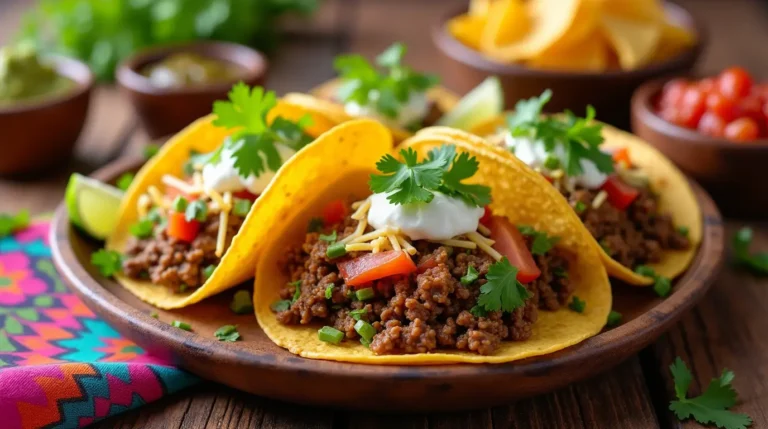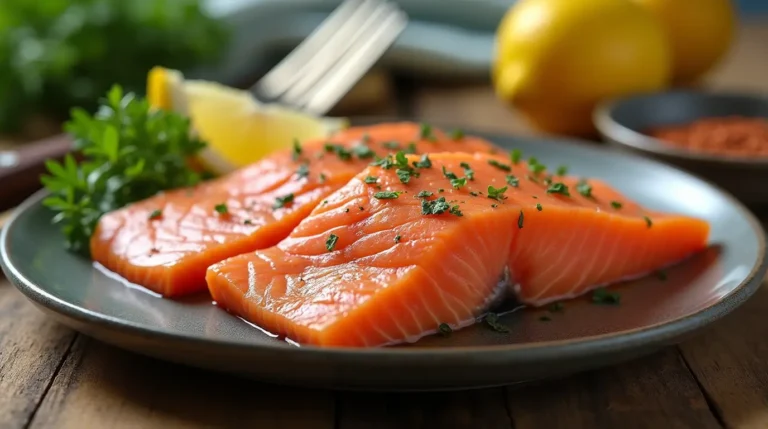Easy Old Fashioned Vegetable Beef Soup Recipe
There’s a special warmth from a pot of old fashioned vegetable beef soup. It fills the kitchen with memories of family dinners and cozy nights. This recipe is more than just a meal; it connects us to our ancestors who made simple ingredients into something comforting.
Whether you’re new to cooking or looking for a classic favorite, this soup offers rich flavors. It’s easy to make, without complicated steps.
Table of Contents

Imagine the steam from a bowl of hearty vegetables and tender beef. It’s like a hug in every spoonful. This recipe celebrates simplicity: it’s slow-cooked for depth, adaptable for any season, and perfect as your go-to comfort food.
By the end, you’ll see why it’s been a favorite in American kitchens for decades.
Key Takeaways
- Rediscover a timeless recipe cherished by generations of home cooks.
- Master a comforting dish using simple ingredients and straightforward steps.
- Learn how to balance flavors for a soup that’s both hearty and approachable.
- Discover tips for making the recipe work with seasonal vegetables or dietary preferences.
- Enjoy a soup that’s perfect for cold nights or weeknight dinners alike.
The History Behind Traditional Vegetable Beef Soup
Traditional beef and vegetable soup has deep roots in American kitchens. It started with early settlers who used soups to stretch ingredients. Over time, it became a symbol of resilience, adapting to cultural and economic shifts.
Origins of Vegetable Beef Soup
Settlers in the 18th and 19th centuries used what they had—potatoes, carrots, and tough beef. They cooked it slow to make the meat tender and stretch meals. Cookbooks like Fannie Farmer’s 1918 edition showed recipes with dried beans and seasonal veggies.
Why This Soup Has Stood the Test of Time
During the Great Depression, this soup was a nourishing, affordable meal. It mixed leftovers with fresh ingredients, becoming a staple. Families still cherish notes from grandmothers, showing its lasting legacy.
Regional Variations Across America
- Midwest: Chicago’s tomato-based broths became popular, using local veggies.
- South: Okra thickens the soup in Southern kitchens, mixed with Cajun spices.
- West Coast: Pacific Northwest versions add mushrooms and barley for extra heartiness.
From frontier cabins to modern kitchens, this soup connects us to the past. Each region’s twist keeps the traditional beef and vegetable soup tradition alive, showing its timeless appeal.
Why You’ll Love This Old Fashioned Vegetable Beef Soup Recipe
The best vegetable beef soup warms you from the first spoonful. It’s made with slow-cooked beef, tender veggies, and herbs. Each bite is rich, just like homemade cooking.
- Cost-effective with budget-friendly ingredients
- Leftovers taste even better the next day
- Easy to adapt for gluten-free or dairy-free diets
This soup is more than a meal—it connects you to your past. Many remember their grandma’s soup simmering all day. It creates memories, just like this recipe does.
It’s perfect for a cozy night or a family gathering. This soup becomes a tradition in your home. It’s the best vegetable beef soup that’s both comforting and convenient.
Essential Ingredients for Authentic Vegetable Beef Soup
Making classic vegetable beef soup begins with the right ingredients. Each part is crucial for that home-cooked taste. Let’s explore what makes each ingredient important.
Choosing the Best Cuts of Beef
Start with beef cuts that have fat and connective tissue. Chuck roast or stew meat become tender as they cook. Lean cuts like sirloin stay tough.
- Chuck roast: 2-3 pounds for rich broth
- Stew meat: Pre-cut cubes for even cooking
Must-Have Vegetables for Traditional Flavor
Classic recipes use carrots, celery, and onions. These veggies offer sweetness and earthiness. Potatoes add creaminess, whether pureed or whole. Don’t skip the core four, even if you add seasonal veggies.
Herbs and Seasonings That Make a Difference
Herbs like bay leaves, thyme, and parsley are essential. Use fresh herbs when you can. Add black pepper at the end to keep its flavor sharp.
Stock Options: Homemade vs. Store-Bought
| Option | Pros | Cons |
|---|---|---|
| Homemade stock | No added salt/ingredients | Requires 4-6 hours |
| Store-bought | Convenient | Check sodium levels |
For store-bought, Swanson or Kitchen Basics are good choices. For a quick homemade stock, simmer bones for 30 minutes.
Kitchen Tools You’ll Need
To make homemade vegetable beef soup, you need a few important tools. First, use a 6- to 8-quart Dutch oven or heavy pot. This ensures even cooking and prevents scorching. A sharp chef’s knife and two cutting boards—one for beef, one for veggies—are also crucial for safe and efficient prep.
- Dutch oven or stockpot: Stainless steel or enameled cast iron is best for durability.
- Cutting tools: An 8-inch chef’s knife makes quick work of beef and root vegetables.
- Measuring spoons: They help you measure salt, pepper, and herbs accurately to avoid overseasoning.
- Ladle and slotted spoon: These are key for skimming fat and serving without spills.
There are affordable options for every tool. If you don’t have a Dutch oven, a large soup pot will do. Plastic or silicone spatulas are great for stirring without scratching surfaces. Airtight storage containers keep leftovers fresh for reheating. With the right tools, your homemade vegetable beef soup will simmer perfectly every time.
Preparing Your Ingredients: Cutting and Measuring Tips
Getting your ingredients ready is crucial for a great hearty vegetable beef soup. The right prep makes each part of the soup better. It adds depth and keeps the soup smooth.
Proper Beef Preparation
Start by trimming the beef chuck to remove excess fat. Leave a thin layer to keep it moist. Cut it into 1-inch cubes for even browning.
Pat the meat dry with paper towels before browning. This helps get a golden crust.
Vegetable Cutting Techniques
- Root vegetables (carrots, potatoes): Dice into ½-inch cubes for slow, even cooking.
- Delicate veggies (celery, onions): Thin slices caramelize faster, enhancing umami notes.
- Soft vegetables (zucchini, mushrooms): Add later to preserve texture without overcooking.
Pre-Cooking Organization
Use mise en place to organize your prep: Put ingredients in bowls labeled by step. Here’s a timeline:
- Trim and cube beef first—store in fridge until browning.
- Prep vegetables in order of cooking time (root veggies first, soft veggies last).
- Measure seasonings and broth into containers for quick access.
Organized prep stops last-minute stress. It ensures your hearty vegetable beef soup is full of flavor and texture.
Step-by-Step Old Fashioned Vegetable Beef Soup Recipe
Learn the easy vegetable beef soup recipe with these simple steps. Follow each step closely to mix tradition with ease.

Browning the Beef for Maximum Flavor
Start by heating a heavy skillet over medium-high heat. Dry the beef with paper towels and season with salt and pepper. Cook in batches to avoid overcrowding.
Sear the beef for 3-4 minutes on each side. This step creates a crust that keeps juices and flavors inside.
Building the Soup Base
Move the browned beef to a Dutch oven. Use ½ cup beef broth to deglaze the skillet, scraping off browned bits. Add sautéed onions, carrots, and celery to the pot.
Stir in tomato paste and 2 bay leaves. The deglazed liquid and aromatics make a rich base.
Adding Vegetables at the Right Time
- Layer hearty veggies first: potatoes and parsnips simmer 45 minutes.
- Add cabbage and corn last 20 minutes to retain crisp-tender texture.
- Leafy greens like spinach go in final 5 minutes for vibrant color.
Simmering Secrets for Perfect Texture
Simmer uncovered on low heat for 1.5-2 hours. Stir occasionally to prevent sticking. Taste after 1 hour—adjust salt or add 1 tsp Worcestershire sauce for depth.
Let flavors meld without overcooking the meat.
Troubleshooting Common Soup Issues
Even seasoned chefs face challenges with the old fashioned vegetable beef soup recipe. Here are fixes for common problems to make sure your soup is perfect every time.
- Tough Beef? Overcooked meat? Use tender cuts like chuck or round and simmer until it’s fork-tender.
- Flat Flavor? Add depth with soy sauce or tomato paste. Stir in ½ tsp salt slowly to balance the taste.
- Wrong Consistency? Thin soup? Mix in a roux (butter + flour) or add diced potatoes. Too thick? Thin with broth ¼ cup at a time.
- Vegetables Overcooked? Start with sturdy veggies like carrots, then add softer ones like peas in the last 10 minutes.
| Issue | Cause | Solution |
|---|---|---|
| Greasy broth | Excess fat from beef | Skim fat with a spoon after cooling |
| Cloudy broth | Over-stirring | Simmer gently without rapid stirring |
| Salty soup | Over-salting | Add unseasoned rice or potatoes to absorb excess salt |
Adjust seasoning slowly and check textures often. These tips will help your old fashioned vegetable beef soup recipe stay rich and comforting.
Delicious Variations to Try
Traditional beef and vegetable soup is full of possibilities. Try these changes to fit your schedule or use seasonal ingredients. You won’t lose that classic taste.
Slow Cooker Adaptation
Brown the beef in a skillet first. Then, move it to the slow cooker with all ingredients except tender veggies like peas. Cook on low for 8-10 hours or high for 4-6 hours.
Add delicate veggies in the last 30 minutes. This prevents them from getting overcooked.
Instant Pot Method
Sear the beef right in the pot. Then, add all the ingredients. Pressure cook on high for 40 minutes.
Use the quick release valve for tender meat and crisp-tender veggies. Remember, always leave 1 inch of headspace.
Vegetable Substitutions
Keep the soup’s essence with these seasonal swaps:
| Season | Vegetable Options |
|---|---|
| Spring | Peas, asparagus, green beans |
| Summer | Zucchini, corn, tomatoes |
| Autumn | Butternut squash, mushrooms, leeks |
| Winter | Parsnips, turnips, celery root |
Adjust cooking times for denser veggies. Add winter roots earlier than tender greens like spinach or kale. Stir in greens last minute.
What to Serve with Your Hearty Vegetable Beef Soup
Enhancing your delicious vegetable beef soup experience is all about the right pairings. These simple additions can turn a bowl of soup into a memorable meal. They do so without overpowering its rich flavors.

Classic Bread Pairings
Crisp textures balance the soup’s warmth. Try:
- Crispy garlic toast: Brush with olive oil and bake until golden.
- Cornbread: Serve warm with butter for a Southern touch.
- Cheese biscuits: Mix shredded cheddar into a quick biscuit dough.
Side Salad Suggestions
Light salads refresh the palate between spoonfuls. Consider:
- Greek salad: Tangy feta and cucumbers contrast the soup’s heartiness.
- Apple-walnut: Sweet apples add brightness with a light vinaigrette.
- Classic garden: Mixed greens with balsamic dressing.
Complete Meal Planning
Transform meals with these tips:
- For family dinners: Use bread bowls to serve the soup. Add salad as a first course.
- Entertaining: Garnish servings with fresh herbs. Offer bread baskets and small salads.
- Freeze extras: Portion bread and salad fixings for quick future meals.
Pairing the right sides ensures every bite of delicious vegetable beef soup shines. Experiment with these options to match your meal’s vibe—from cozy weeknights to festive gatherings.
Storage and Freezing Guidelines
Storing your homemade vegetable beef soup right keeps it fresh and delicious for weeks. Here’s how to keep it tasting great:
- Cool soup quickly: Move it to shallow containers and chill in the fridge within 2 hours. This stops bacteria from growing.
- Keep it in airtight containers in the fridge for up to 4 days. Glass containers are best to avoid plastic tastes.
- Freeze it in labeled containers with 1-inch space. Freeze for up to 3 months. Use heavy-duty freezer bags for flat storage.
| Storage Method | Container Type | Max Timeframe |
|---|---|---|
| Refrigeration | Glass or BPA-free plastic | 3-4 days |
| Freezing | Freezer-safe containers/bags | 2-3 months |
When you reheat, use low heat in a pot. Add 1/4 cup broth if it’s too thick. Don’t microwave in metal. For best results, thaw frozen soup in the fridge overnight before reheating.
Before serving, try these tips: stir in fresh parsley or a bit of apple cider vinegar to refresh the taste. Never refreeze thawed soup for safety.
Nutritional Benefits of Homemade Vegetable Beef Soup
Homemade hearty vegetable beef soup is more than just comfort food. It’s a meal full of nutrients. It combines healthy ingredients to support a balanced diet. It offers protein, vitamins, and minerals without any additives.
Protein and Nutrient Content
Beef adds 20-25g of protein per serving. Carrots, celery, and potatoes bring fiber and vitamins A and C. Garlic and onions add antioxidants to boost immunity. Leafy greens like kale or spinach increase iron intake.
Comparing Homemade vs Canned Soup
- Homemade: 500mg sodium/serving vs. 800mg+ in canned brands like Campbell’s
- No preservatives like sodium benzoate found in store-bought options
- 2x more fiber from fresh vegetables compared to processed versions
Making Your Soup More Nutritious
Here are some tips to make your soup even healthier:
- Add barley or quinoa for complex carbs and fiber
- Swap broth for bone broth to boost collagen and minerals
- Use low-sodium broth to cut sodium by 30%
Cooking at home lets you control what goes into your soup. This makes hearty vegetable beef soup a better choice than prepackaged meals. You can adjust recipes to fit your dietary needs, like keto or low-sodium diets.
Conclusion: Enjoying Your Classic Vegetable Beef Soup
Classic vegetable beef soup is a timeless favorite. It’s comforting and brings back memories. It’s perfect for cold evenings or family gatherings.
By following simple steps, you can make a delicious soup. Brown the beef, layer the vegetables, and season it right. This makes your soup better than ever.
Feel free to make it your own. Add different veggies, herbs, or spices. You can cook it in a slow cooker, Instant Pot, or on the stovetop. The key is to keep the core principles.
Sharing this soup with family and friends creates lasting memories. It becomes a special family tradition.
Keep track of your recipe in a journal or app. Each time you make it, you get better. It’s a dish that rewards your effort with delicious results.
Every spoonful of this soup tells a story. It’s simple yet full of tradition. When you serve it, you’re connecting with a long line of cooks. This recipe is a bridge between past and present, loved by all.
FAQ
What is the best cut of beef for vegetable beef soup?
For old-fashioned vegetable beef soup, chuck roast or stew meat are top choices. They have lots of marbling. This makes the soup taste better and feel softer as it cooks.
Can I use frozen vegetables in my homemade vegetable beef soup?
Yes, frozen veggies work great in classic vegetable beef soup. They’re easy to use and add flavor and nutrients. Just add them near the end to avoid overcooking.
How long can I store vegetable beef soup in the refrigerator?
You can keep homemade vegetable beef soup in the fridge for 3-4 days. Cool it down first to keep it fresh.
Can I make vegetable beef soup in a slow cooker?
Absolutely! Brown the meat first for a slow cooker version. Then, add all the ingredients. Cover and cook on low for 6-8 hours.
How do I make my vegetable beef soup more nutritious?
To make your soup healthier, add more veggies, use whole grains like barley, or choose bone broth. Bone broth adds collagen and minerals.
What seasonings are essential for an authentic vegetable beef soup?
Bay leaves, thyme, and parsley are key for a tasty vegetable beef soup. They boost the flavor and give it a classic taste.
Are there any common mistakes to avoid when making vegetable beef soup?
Yes, don’t skip browning the beef, add veggies in stages, and season well. Each step is important for a rich flavor.
Can I freeze leftover vegetable beef soup?
Yes, freeze leftover soup for 2-3 months. Leave space in containers for expansion. Add fresh herbs after thawing for better flavor.
How can I thicken my vegetable beef soup if it turns out too thin?
To thicken, make a roux, add mashed potatoes, or simmer uncovered. This lets some liquid evaporate.
What are some good side dishes to serve with vegetable beef soup?
Serve with crusty French bread or cornbread. A fresh salad is also a great side to balance the meal.







